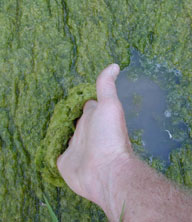What is Impairing the Health of Maryland's Streams?
Main_Content
This section covers challenges that the Maryland Department of Natural Resources faces in protecting and conserving Maryland's Rivers and Streams.
Invasive Species
Aggressive exotic species are known to alter food webs, destroy habitat, and push out important native species. Maryland's streams are not exempt from countless invasions from a variety of sources. The large and aggressive Rusty crayfish (native to Kentucky and Ohio) were introduced through bait buckets that were dumped into Maryland streams, and threaten several native species of crayfish. For more information about invasive species and what you can do, go to Maryland Department of Natural Resources Invasive Species Page
Climate Change
The global rise in average temperature has multitude of effects on rivers and streams. Increased water temperatures can affect life cycles of several species of insects and fishes. More powerful storms can lead to increased erosion and runoff from urban areas, which can put increased levels of sediment, trash, and pollutants into streams, as well as destroy valuable riparian buffer vegetation.
Species Homogenization
Unique native (and endemic) species are being lost from many Maryland streams. At the same time, non-native and widespread species (such as northern snakeheads) are becoming increasingly common. This is often referred to as "biological homogenization". because the result is streams that used to have different species now having the same, common species. In an article in Science in 2000 Frank Rahel showed that the fish assemblages in US states are, on average, 7% more similar to each other now than they used to be. The primary drivers for biological homogenization in streams are non-native species introductions, pollution, and habitat loss. Pollution and habitat loss contribute to homogenization by making habitats less suitable for intolerant native species, thus facilitating the establishment of tolerant non-natives.
Land Use
As more areas in Maryland switch from forest to agriculture or urban land use, the adjacent streams are affected in a variety of ways. Stripping streams of riparian shading increases temperature, runoff, and sediment loading. Increasing the amount of impervious surface in a watershed leads to a rise in flash flooding, flashiness in temperature, and degraded habitat for the multitude of species that utilize the stream.
Learn more about how land use changes habitats in this informative slide show.
More information about urbanization and how it imperils Maryland's streams can be found in this  article.
article.
Nutrient Loading
 Nitrogen and phosphorus are the two common nutrients that pollute our streams. The most widespread source of nutrients in streams is excess fertilizer from farm fields and lawns. These chemicals may either run off the land during storms or soak into the ground and pollute groundwater that may take years or even decades to reach a stream. Although nutrients in sewage may impact many Maryland waterways, sewage treatment plants are often situated on larger rivers and usually do not affect small streams. Septic systems can be a source of nutrients in rural areas and areas with low density development. Other sources include animal manure, airborne compounds in smokestack emissions, and auto exhaust.
Nitrogen and phosphorus are the two common nutrients that pollute our streams. The most widespread source of nutrients in streams is excess fertilizer from farm fields and lawns. These chemicals may either run off the land during storms or soak into the ground and pollute groundwater that may take years or even decades to reach a stream. Although nutrients in sewage may impact many Maryland waterways, sewage treatment plants are often situated on larger rivers and usually do not affect small streams. Septic systems can be a source of nutrients in rural areas and areas with low density development. Other sources include animal manure, airborne compounds in smokestack emissions, and auto exhaust.
Although excess nutrients in small streams may produce an overabundance of algae and other plants, the most devastating effect is in tidal embayments and Chesapeake Bay. Here, in combination with other factors such as stagnant water and high temperatures, excess nutrients may contribute to large-scale algae blooms and fish kills.
Stream Blockages
Stream blockages, including road culverts and dams, can pose significant risks to aquatic biodiversity. Due to inadequate designs, many of these man-made structures block the movement of migratory fishes, fragment populations of many resident aquatic animals, and lead to degraded habitat quality through the alterations of water flow and transport of sand and silt. The Patapsco River, located southwest of Baltimore City, is intersected by several dams that are impacting the natural stream communities...
 Continue this story
Continue this story
Acidification
Reductions in acid deposition have the potential to improve the condition of Maryland surface waters,
particularly in small streams most susceptible to acidification. Maryland's Department of Natural Resources has
long recognized acid deposition as an important regional concern. In 1987, the Maryland Synoptic Stream
Chemistry Survey found that approximately one-third of all headwater streams in the state were sensitive to acid
deposition or were already acidic as a result of deposition. The Maryland Biological Stream Survey continues to
examine the current status of stream acidification as well as its effects on aquatic life.
Stream Temperature
Fluctuations in stream temperature can have adverse effects on the life in Maryland's rivers and streams. Many
insects rely on temperature as a trigger to start changing from their larval stage to become adults. If they emerge too soon, they risk a premature death, which not only affects their populations, but the fish and other
species that rely on them for food. In addition, certain fish (most notably trout) will only use certain streams for habitat if their temperatures stay suitably low.